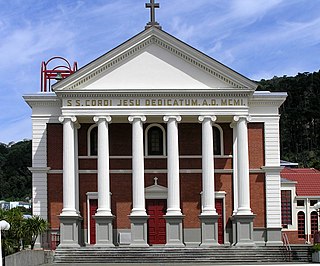
The Catholic Church in New Zealand is part of the worldwide Catholic Church under the leadership of the Pope in Rome, assisted by the Roman Curia, and with the New Zealand bishops.

Ponsonby is an inner-city suburb of Auckland located 2 km west of the Auckland CBD. The suburb is oriented along a ridge running north–south, which is followed by the main street of the suburb, Ponsonby Road.
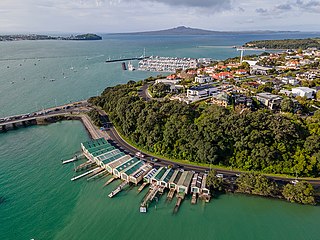
Ōrākei is a suburb of Auckland city, in the North Island of New Zealand. It is located on a peninsula five kilometres to the east of the city centre, on the shore of the Waitematā Harbour, which lies to the north, and Hobson Bay and Ōrākei Basin, two arms of the Waitematā, which lie to the west and south. To the east is the suburb of Mission Bay. Takaparawhau / Bastion Point is a coastal piece of land in Ōrākei. Between Takaparawhau and Paritai Drive is Ōkahu Bay and Reserve.

Peter Louis Marie Chanel, SM, was a Catholic priest, missionary, and martyr. Chanel was a member of the Society of Mary and was sent as a missionary to Oceania. He arrived on the island of Futuna in November 1837. Chanel was clubbed to death in April 1841 at the instigation of a chief upset because his son converted.
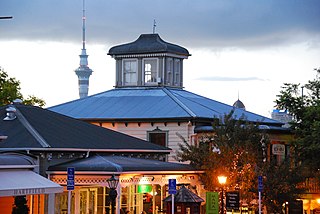
Parnell is a suburb of Auckland, New Zealand. It is one of New Zealand's most affluent suburbs, consistently ranked within the top three wealthiest, and is often billed as Auckland's "oldest suburb" since it dates from the earliest days of the European settlement of Auckland in 1841. It is characterised by its mix of tree-lined streets with large estates; redeveloped industrial zones with Edwardian town houses and 1920s bay villas; and its hilly topography that allows for views of the port, the Waitematā Harbour, Rangitoto Island and the Auckland Domain. To its west lies the Auckland Domain, to the south Newmarket, and to the north the Ports of Auckland.

Saint Marys Bay is an inner suburb of Auckland, New Zealand.
Pompallier Catholic College is a Catholic co-educational secondary school located in the suburb of Maunu in Whangārei, New Zealand. It is one of nine secondary schools within the Marist network. Pompallier Catholic College is named after Bishop Jean Baptiste Francois Pompallier who led the first group of Catholic Missionaries from Lyons, France, to New Zealand. The patron saint of the college is John the Baptist. Students of Pompallier Catholic College are colloquially known as Pompallians.

Takaparawhau / Bastion Point is a coastal piece of land in Ōrākei, Auckland, New Zealand, overlooking the Waitematā Harbour. The area is significant in New Zealand history as the site of protests in the late 1970s by Māori against forced land alienation by Pākehā. Takaparawhau is now the site of the private Ōrākei Marae, the public Michael Joseph Savage Memorial, and privately-owned reserve land that is accessible to the public.

Jean-Baptiste François Pompallier was the first Roman Catholic bishop in New Zealand and, with priests and brothers of the Marist order, he organised the Roman Catholic Church throughout the country. He was born in Lyon, France. He arrived in New Zealand in 1838 as Vicar Apostolic of Western Oceania, but made New Zealand the Headquarters of His Catholic Mission.
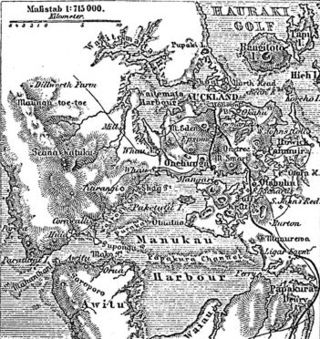
The human history of the Auckland metropolitan area stretches from early Māori settlers in the 14th century to the first European explorers in the late 18th century, over a short stretch as the official capital of (European-settled) New Zealand in the middle of the 19th century to its current position as the fastest-growing and commercially dominating metropolis of the country.
Philippe Joseph Viard was a French priest and the first Bishop of the Catholic diocese of Wellington, New Zealand.
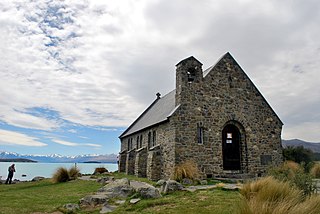
Christianity in New Zealand dates to the arrival of missionaries from the Church Missionary Society who were welcomed onto the beach at Rangihoua Bay in December 1814. It soon became the predominant belief amongst the indigenous people, with over half of Māori regularly attending church services within the first 30 years. Christianity remains New Zealand's largest religious group, but no one denomination is dominant and there is no official state church. According to the 2018 census 38.17% of the population identified as Christian. The largest Christian groups are Anglican, Catholic and Presbyterian. Christian organisations are the leading non-government providers of social services in New Zealand.

The Auckland Central Business District (CBD), or Auckland city centre, is the geographical and economic heart of the Auckland metropolitan area. It is the area in which Auckland was established in 1840, by William Hobson on land gifted by mana whenuahapū Ngāti Whātua Ōrākei. It is New Zealand's leading financial hub, and the centre of the country's economy; the GDP of the Auckland Region was NZD$139 billion in the year ending September 2023.

St Paul's Church is an historic Anglican church, located on Symonds Street near the University of Auckland and Auckland University of Technology, in the central business district of Auckland, New Zealand. The church is the longest established parish in the city and has one of the largest Anglican congregations in Australasia.
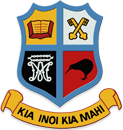
Hato Petera College was an integrated, co-educational college in Northcote Central, Auckland, New Zealand for students from Year 9 to Year 13. It existed for 90 years, opening on 3 June 1928 and closing on 31 August 2018. The school had a strong Catholic and Māori character. It was located on part of the land originally given by Sir George Grey, Governor of New Zealand, to Bishop Pompallier, the first Bishop of Auckland, in 1849 for education purposes.

The Cathedral of Saint Patrick and Saint Joseph is an heritage-listed Catholic cathedral church in Auckland CBD, situated on the corner of Federal Street and Wyndham St. It is the mother church of the Roman Catholic Diocese of Auckland and the seat of the Bishop of Auckland.
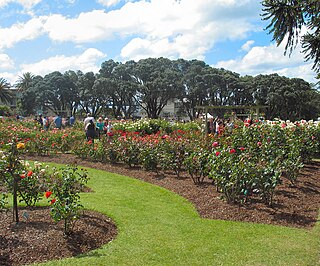
Dove-Myer Robinson Park, more commonly known as the Parnell Rose Garden, is a park in Parnell, Auckland, New Zealand. The park is named after Dove-Myer Robinson, the longest-serving mayor of Auckland, who served for 18 years. There are over 5,000 roses in the garden. Some of the plants in the garden have been bred by internationally celebrated rose breeders.

Apihai Te Kawau was a paramount chief of the Ngāti Whātua Māori iwi (tribe) of Auckland, New Zealand in the 19th century.
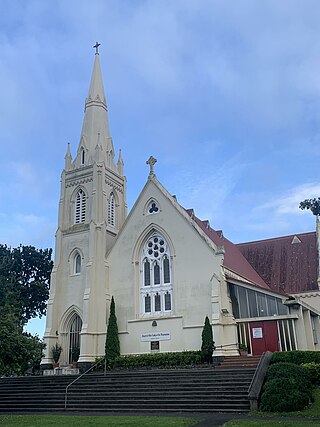
Our Lady of the Assumption is a heritage-listed Catholic church located in Auckland, New Zealand. It is located in the suburb of Onehunga on the corner of Church Street and Galway Street. Built between 1887–9 the church is situated within a 1840s denominational cemetery which houses the gravesites of many of Onehunga's fencible colonial settlers.

St James Anglican Church is a category II heritage listed Anglican church in Māngere Bridge, Auckland, New Zealand. Built in the 1850s it is the only remaining stone Selwyn church in Auckland.




















